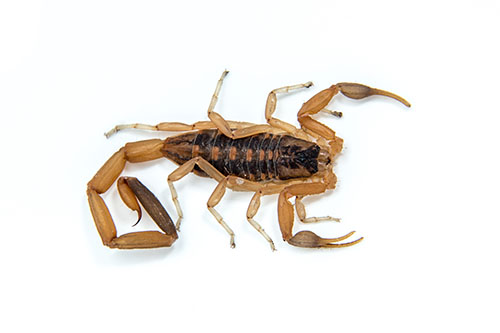Scorpions
Scorpions are not classified as insects but as arachnids. This makes them close relatives of ticks, mites, and spiders. There are approximately 50 species of scorpions that occur in the continental United States, but most of these are found in the Southwest. The exact number of species in Oklahoma has been estimated at between three and five, but only one species is common to the entire state, the Bark Scorpion.
Schedule a FREE evaluation
(405) 973-5522
Identify Scorpions
Scorpions are easily recognized by their characteristic shape. All scorpions have a long, slender body with a five-segmented tail that can be arched over the back. The tail ends in a bulb-like poison gland or stinger. Scorpions have four pairs of legs and two large pincer-bearing arms (pedipalps) in front. Scorpions are well equipped to defend themselves or attack prey with their pincers and stinger. Between the last pair of legs is a comb-like structure (pectines) that is used to identify surface textures and to detect prey.
Scorpions have two eyes on the top of the head, and usually two to five pairs of eyes along the front corners of the head. They do not see well, however, and must rely on the sense of touch, using their pectines and other organs for navigation and hunting. Their bodies are flat, which allows them to hide in small cracks, under rocks and under bark.
Bark scorpions are smaller than most scorpions (1-2 inches long). The pincers are long and thin, and its abdominal segments are longer and more slender than other scorpions. The color may vary from light tan to a darker golden brown. It is also the only scorpion that curls its tail to the side while at rest.

Scorpion Characteristics
Scorpions are nocturnal. They often ambush their prey, lying in wait as they sense its approach. They consume all types of insects, spiders, centipedes, and other scorpions. Larger scorpions may feed on vertebrates, such as smaller lizards, snakes, and mice if they are able to subdue them. They capture their prey with their pedipalps, paralyzing them with their venom as well if necessary. The immobilized prey is then subjected to an acid spray that dissolves the tissues, allowing the scorpion to suck up the remains.
Most scorpion species are solitary in nature. The exception to this is bark scorpions, which may over-winter in aggregates of 20-30. The bark scorpion is also one of relatively few species that are able climbers.
The venom of the bark scorpion may produce severe pain (but rarely swelling) at the site of the sting, numbness, frothing at the mouth, difficulties in breathing (including respiratory paralysis), muscle twitching, and convulsions. Death is rare, especially in more recent times. Antivenin is available for severe cases. Certain people, however, may be allergic to the venom and can experience life-threatening side effects when stung (as occurs with bee stings).
Their bodies are covered with a waxy cuticle which also helps reduce water loss. For reasons yet unknown, the scorpion cuticle fluoresces under ultraviolet light i.e., a blacklight.
At Risk Areas
They are considered “bark scorpions” due to their distinct association with dead vegetation, fallen logs, and human dwellings. It is common for them to climb, and many reports in homes are associated with attics.
- Rocks
- Wood Piles & Firewood
- Loose Boards
- Old Tires
- Under Flat Stones
- Near Ponds
- Crumbling Foundations
- Overhanging Trees
- On Walls
- Closets
- Beds
- Garages
- Storage Sheds
- Cellars
- Attics
- and more…
Schedule
405-973-5522
